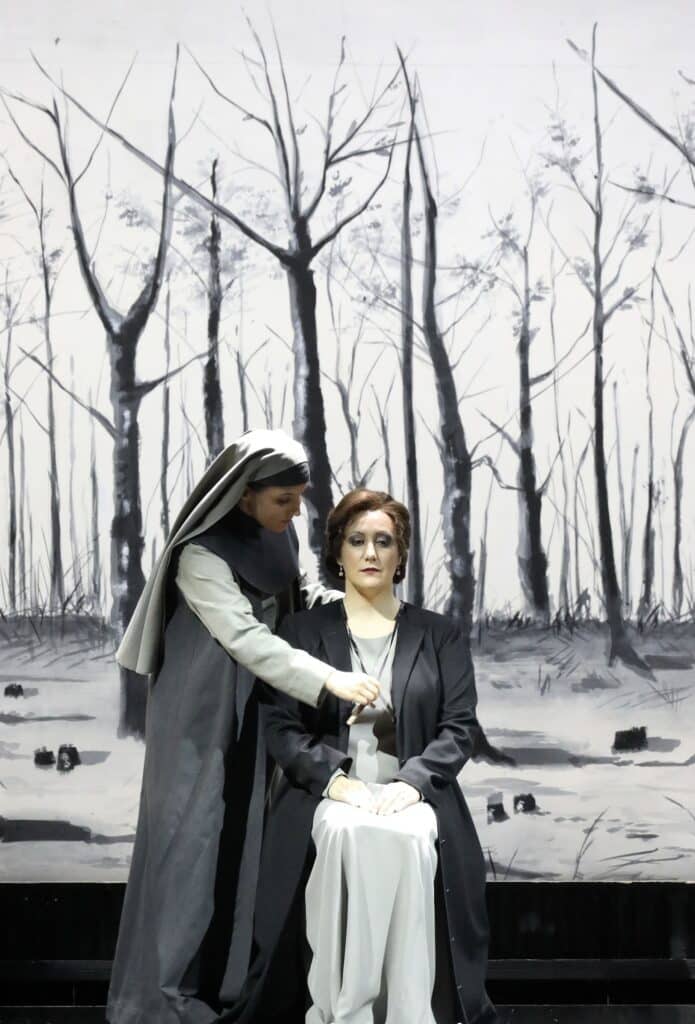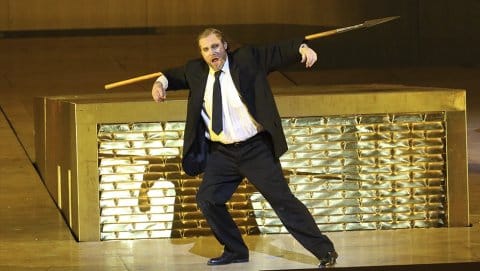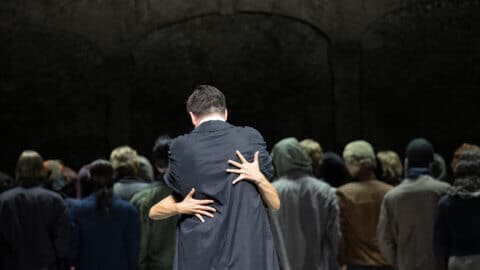THE TROUBADOUR – MUNICH OPERA FESTIVAL
★★★★★☆

Photo: Wilfried Hösl
REVIEW THE TROUBADOUR: VERDI’S GHOST OPERA QUIVERS WITH EROTICIS IN MUNICH
French director Oliver Py has created a mega production of The Troubadour that lives up to all Francophile clichés with a grandiose, refined stage design and an interpretation of Verdi’s ghost opera that quivers with eroticism.
The set, which consists of a 4-5 story medieval building in what looks like full size, is so big that I can’t believe they managed to fit it on the stage of the Bayerische Staatsoper, which hosts the Munich Opera Festival.
A festival that impresses with its unconditionally high quality of directors and soloists and is always worth a trip.
The main purpose of my festival visit was the opening performance of Le Grand Macabre, which you can find reviewed here on GOT TO SEE THIS, but as an added bonus I was more than pleasantly surprised to see the revival of Oliver Py’s 2013 production of Verdi’s haunting classic.
This Troubadour (Il Trovatore) is, in short, a great and thoroughly entertaining opera experience.
The visual center, the medieval building in black wood, which simultaneously signals a gloomy castle and village idyll, is placed on a revolving stage and opens up with several rooms and smaller scenes at the front, back, top and bottom, where a great deal of eroticism unfolds in tantalizing flashbacks and flashforwards that tie the story’s many gusty plot threads together in a convincing whole.
Of course, it doesn’t hurt that Munich is spoilt with a cast of top singers.
Verdi is an expert in so-called number operas, which encourage applause between hit arias. And the discerning German audience is thrilled by the soloists who deliver at the highest level and bathe themselves in deserved cheers.
Romanian baritone George Petean is one of the most sought-after performers of Verdi’s baritone roles today, and he offers a formidable Count Luna, while the key role of Leonora is handled with equilibrism and fervor by Latvian soprano Marina Rebeka.
As Azucena, Russian Yulia Matochkina satisfies with a confident mezzo, while Italian tenor Vittorio Grigolo is criticised for overplaying the drama in the role of Manrico, though he delivers an honorable version of the hit aria Di Quella Pira in Act 3.

Photo: Wilfried Hösl
Py goes all out in a flashy metalayer with muscular, half-naked dancers in animal masks saber-fighting barefoot in slow motion. Also fantastic is the crazy locomotive scene with the men hammering anvils while a stripped girl dances wildly above – a furious fusion of desire and masculine, almost homoerotic violence.
The Troubadour is a convoluted and completely unbelievable story about a servant woman who is burned at the stake as a witch after being unjustly accused of causing the feverish death of a count’s baby.
At the execution, she is avenged by her daughter Azucena, who accidentally murders her own son by throwing him into the flames.
Azucena abducts the remaining second son of the count and raises him as her own under the name Manrico.
Perhaps it’s her rebellious temperament that leads Manrico to become the leader of a resistance group fighting the local ruler Count Luna, unaware that Luna is his own brother who has been searching for him all his life.
They are even in love with the same woman, and it ends fatally when Luna is ‘tricked’ into executing Manrico, unaware of the brotherhood, before it is too late. The revenge of the witch who wasn’t a witch is now complete. Are you with me?

Photo: Wilfried Hösl
There are many candidates for the title of Most Improbable Opera Plot, but Il Trovatore is one of the top contenders. That’s saying something.
Despite its obvious plot weaknesses, The Troubadour still stands as a highlight of the opera genre, thanks to Verdi’s phenomenal music.
A memorable experience in Munich (conductor Francesco Ivan Ciampa) on a night when both Denmark and Italy were eliminated from the European Football Championship. But Verdi managed to defend the Italian reputation in the best possible way.

Photo: Wilfried Hösl
Director Oliver Py, who is also an actor, librettist, writer and theatre manager, was a new encounter for me, and I was deeply impressed by the staging (sets and costumes by Pierre-Andre Weitzs), which was a kind of retro-industrial punk – immensely voluminous, but also aesthetically refined in its dark, sexy output, with huge, rotating, steam engine-like mechanics in the scenography that rotated incessantly as a kind of illustration of the ever-churning wheel of tragedy.
Oliver Py describes himself as a Catholic and homosexual with an artistic focus on both disciplines, has stated ambitions to do Wagner’s Ring, which could certainly be an exciting experience in this director’s staging. He can soon be seen with Rake’s Progress and Carmelite’s in Paris and Sicilian Vespers at the Deutsche Oper this spring. We’ll keep an eye out for that.
For now, five stars for The Munich Troubadour from GOT TO SEE THIS.




